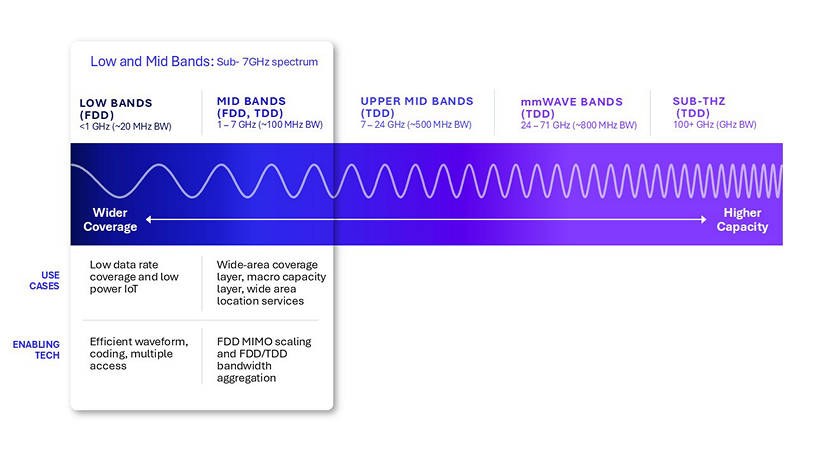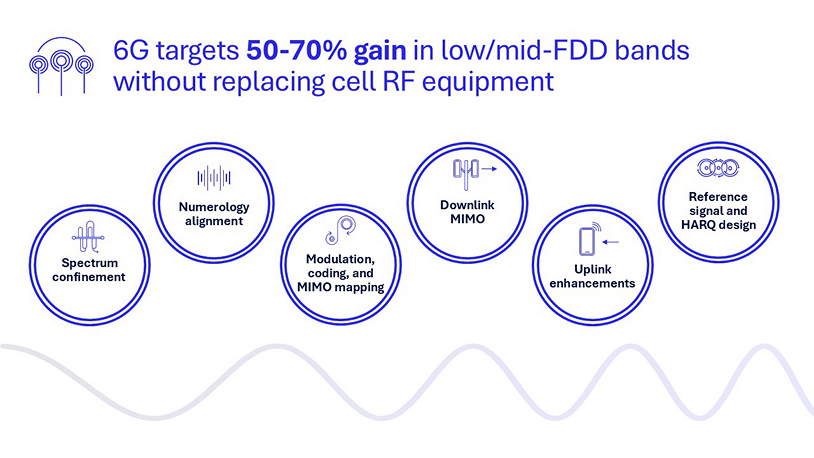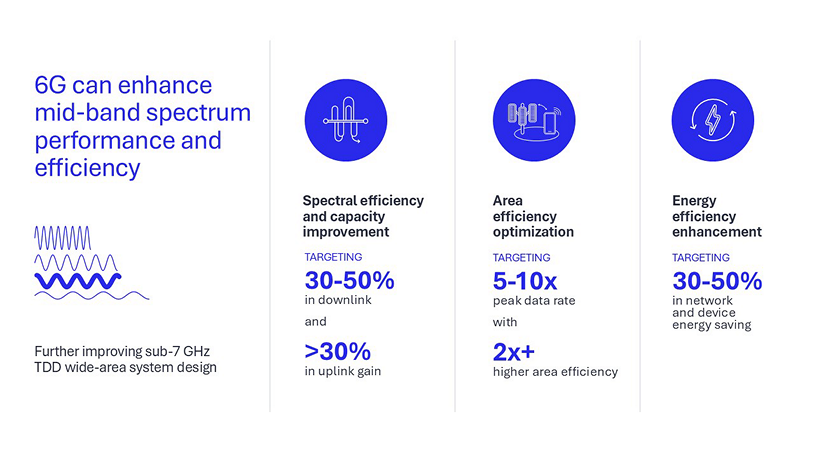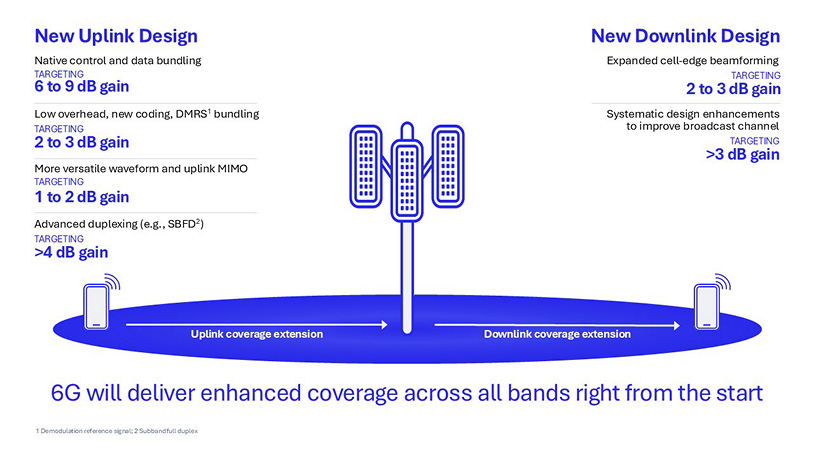6G research points to a new lower-band system spectrum design to significantly improve wireless capacity, coverage and efficiency
A new lower-band spectrum design for 6G can benefit all ecosystem players and end users by:
- Ultimately improving the quality of experience, which is essential for customer satisfaction.
- Increasing capacity and delivering more dependable connectivity.
- Driving better economics and enabling new use cases at scale.
Wireless technology is evolving continuously to improve the way we connect and interact with the world. From facilitating mobile communication to supporting novel applications like environmental sensing and immersive extended reality (XR), the impact of wireless innovations continues to grow. In fact, wireless connectivity is an essential component of our vision to enable intelligent computing everywhere.
To meet the connectivity demand of the coming decade and beyond, we are driving technology advancements across all vectors, focusing on evolving the wireless foundation, optimizing system efficiencies and bringing emerging use cases to life and at scale. Industry forecasts project continued global mobile data traffic growth, expected to quadruple by 2030 at a compound annual growth rate (CAGR) of 23% from 2023.1 This is fueled by mobile broadband, as well as new use cases made possible by AI-enabled services. These trends highlight the need for proactive strategies to ensure that new networks can support tomorrow’s requirements.
Meeting network coverage and capacity demand is essential; without adequate support, even the simplest use cases risk falling short. Building on the technology foundation is critical to unlocking the full potential of next-generation wireless connectivity.
In this sixth installment of the 6G foundry series, we will see how a new lower-band spectrum system design coming with 6G can deliver enhanced wireless system coverage and capacity.
Innovating in the existing lower-band spectrum
6G offers a once-in-a-generation opportunity to redesign the low and mid-band spectrum (e.g., frequencies below 3 GHz), also driven by the global momentum to re-farm spectrum from older network generations (e.g., 2G and 3G). The targeted spectrum (e.g., 900 MHz, 1800 MHz, 2100 MHz) are exclusively in the low and mid-bands. Refarming these bands will free up existing bandwidth for a more efficient technology to be deployed, thereby achieving potentially significant spectral efficiency gains.
Meanwhile, cellular system dimensions have expanded significantly in these bands, with bandwidth increasing up to over 20 MHz and the number of device-side antennas scaling from 1Tx2Rx to at least 2Tx4Rx. Additionally, modem processing power has increased more than 100 times over the last several decades. These fundamental design assumption changes are driving the need for a new air interface design, targeting to achieve substantial performance gain over 5G, which primarily focused on enabling new TDD bands in both FR1 C-band (e.g., 3.5 GHz) and FR2 mmWave-band (e.g., 28/39 GHz).
The performance improvement in lower-band spectrum is important for wide-area use cases, such as smartphones, wearables and the internet of things (IoT).
The new lower-band spectrum design targets to include a variety of techniques that collectively deliver significant spectral efficiency and coverage gains. Let’s dive into some more details.

New design techniques for low- and mid-band FDD
In the low- and mid-band FDD spectrum bands (e.g., 800 MHz, 900 MHz), a new 6G baseband design is targeted at delivering a 50-70% capacity improvement over 5G, all without replacing cell RF equipment. Here are a few enabling techniques:
- Spectrum confinement: With advanced signal processing, 6G can pack more signals for the same bandwidth by reducing the guard band between carriers, compared to 5G FDD design.
- Numerology alignment: A more seamless mid-band FDD and TDD integration can be achieved via numerology alignment. Using the same numerology synchronizes the scheduling heartbeat between mid-band FDD & TDD to enhance coordinated operations, thereby improving user experience and network efficiency.
- Modulation, coding, MIMO mapping: A new 6G baseband design can adopt enhanced low-density parity check (LDPC) channel coding, constellation shaping and new MIMO mapping to provide 20%+ improvements over 5G design in FDD bands.
- Downlink MIMO: MIMO channel state feedback design with advanced signal processing and AI techniques can bring an additional 20%+ gain over 5G eType-II channel state information (CSI) for downlink multi-user MIMO scenarios.
- Uplink enhancements: Joint design across waveform, modulation and MIMO beamforming can provide 2dB gain over 5G NR in the uplink. Furthermore, improved uplink antenna selection and advanced power management can offer an additional 2-3dB gain compared to 5G in lower/mid-bands.
- Reference signal and HARQ design: 6G reference signal design will incorporate the best elements of 4G cell specific reference signal (CRS) and 5G demodulation reference signal (DMRS). Along with a new hybrid automatic repeat request (HARQ) and rate adaptation framework, an additional 15-20% gain could be achieved on top of previous enhancements across uplink and downlink.

New design techniques for mid-band TDD
Shifting our focus to the mid-band sub-7GHz TDD spectrum. These wide-area capacity bands will continue to be essential in the 6G era, and we expect ongoing advancements in these bands. Here are some techniques that can further improve the performance in this band range:
- Spectral efficiency: The new 6G baseband is designed to enhance spectral efficiency by 30% to 50% in TDD bands. This allows 6G to deliver significantly higher data rates through advanced baseband techniques (e.g., modulation, coding, MIMO mapping, interleaving, data and control channels, reference signaling, and coherent MIMO beamforming), while also improving spectral efficiency.
- Area efficiency: Several key innovations in 6G’s physical (PHY) and media access control (MAC) layers (e.g., new HARQ and rate control framework, streamlined TDD and carrier aggregation designs), can work together to enhance implementation efficiency compared to 5G. It also allows both the network and the device to optimize performance for area efficiency at peak envelope. The first 6G modem is expected to achieve much higher peak data rates than the first 5G modem, while also achieving significantly greater area efficiency.
- Energy efficiency: The enhanced spectral efficiency in 6G naturally translates to better energy efficiency. These designs are expected to reduce network energy consumption by 30% to 50% in loaded cells. Additionally, lightly-loaded or unloaded cell energy efficiency can be further improved with techniques like lean initial access, reduced always-on signaling, enhanced adaptation framework, low-power wakeup signal (WUS), more UE autonomous contention-based UL transmission and fast wideband access protocol design.

Targeting coverage enhancements for all bands for 6G
The refreshed design will also aim to improve coverage across all frequency bands — another key priority in our 6G research.
In the 6G system, we have been working to develop coverage-native designs for both uplink and downlink across all frequency bands. We aim to achieve significant coverage gains through a variety of innovative techniques. For instance, we will introduce lean broadcast control channels for downlink, and more flexible slot bundling for data channels and a more versatile Discrete Fourier Transform-Spread (DFT-S) waveform family design for uplink.
Enabling these coverage-native designs from the very first release of 6G will bring the most benefits. This approach ensures that all 6G devices benefit from robust coverage right from the start, rather than waiting for enhancements in later releases. Here is a closer look at the techniques that can improve downlink and uplink coverage.

The path forward
6G is set to advance the strong foundation established by 5G. The new 6G baseband design is expected to deliver a 50-70% capacity improvement over 5G in low- and mid-bands, without the need for upgrades to cell-site RF or antenna hardware. This represents a significant improvement compared to the FDD upgrade from 4G LTE to 5G, which only incrementally provided a 10-15% capacity boost.
One of the promising aspects of 6G is its potential to seamlessly integrate with existing 5G FDD and TDD bands through multi-RAT spectrum sharing (MRSS) technology. This approach can facilitate an efficient and rapid transition to 6G.
In the coming months, we look forward to sharing more details of our ongoing research. Stay connected for more updates as we explore the future of wireless connectivity.
Want to learn more?
Check out our new 6G content hub
Sign up for our wireless technologies newsletter to stay up to date

